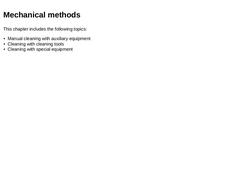
|
|

|
Other methods In unique situations, special methods are used for cleaning, as e.g.: -
Physical methods (increase of the flow velocity)
-
Ultrasonic methods
-
Chemical methods
-
Biological methods
Physical methods Physical methods aim at an increase of the sewage flow velocity for cleaning purposes by adding air ( (Cleaning of pressure lines) and (Cleaning of inverted siphons)) or polymers. The effect of the polymers is based on a decrease of the energy … |
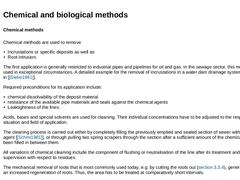
|
Chemical methods Chemical methods are used to remove -
Incrustations or specific deposits as well as
-
Root intrusion.
The first application is generally restricted to industrial pipes and pipelines for oil and gas. In the sewage sector, this method is only used in exceptional circumstances. A detailed example for the removal of incrustations in a water dam drainage system can be found in [ [Siebe1981]]. Required preconditions for its application include: |

|
|
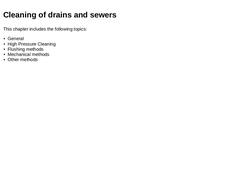
|
|
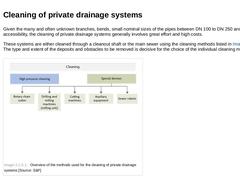
|
Given the many and often unknown branches, bends, small nominal sizes of the pipes between DN 100 to DN 250 and difficult accessibility, the cleaning of private drainage systems generally involves great effort and high costs. These systems are either cleaned through a cleanout shaft or the main sewer using the cleaning methods listed in Image 3‑109. The type and extent of the deposits and obstacles to be removed is decisive for the choice of the individual … |
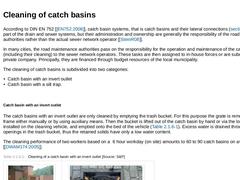
|
According to DIN EN 752 [ [EN752:2008]], catch basin systems, that is catch basins and their lateral connections ( (Drain systems)), form part of the drain and sewer systems, but their administration and ownership are generally the responsibility of the road maintenance authorities rather than the actual sewer network operator [ [SteinR08]]. In many cities, the road maintenance authorities pass on the responsibility for the operation and maintenance … |

|
When cleaning large profiles, special requirements have to be met depending on, for example, the nominal size, pipe material and deposit situation. The cleaning might involve a great deal of time and effort. The structural condition of an individual large profile sewer also needs to be taken into account. Older/aged sewers made of brickwork might for example be damaged due to corroded joints and washed out foundation joints. These facts have to be … |

|
The cleaning system from the company CSM BESSAC [ [FI-CSM]] combines the removal and transportation of debris with the function of a transport vehicle. The components of the system are installed on a pneumatic-tyred chassis which is driven by a diesel engine with an exhaust catalyst (Image 3‑118). (Image: Cleaning system from the company CSM BESSAC) At the front of the machine is the removal component that is composed of a cleaning blade, which is … |

|
A special development for the removal of deposits in sewers of larger nominal sizes (DN 800 to 3,200) without interrupting the sewer flow is the semi-automatic cleaning system “Sielwolf” [ [Kupcz87]]. It is pulled through the section to be cleaned using a winch. The deposits are removed using high pressure water blasting. This process results in a water-debris mix, or slurry, that is transported via a pump into skip containers which are set up above … |

|
On behalf of the Emscher Association (Essen, Germany) which required a system for the cleaning of sewers with constantly high filling levels and unconsolidated deposits, the Fraunhofer Institute for Factory Operation and Automation IFF (Magdeburg, Germany) developed an automatic cleaning system for large profiles that can also be used for a detailed inspection (section 4 - in progress): The cleaning and inspection system under the name of “SVM-RS” … |

|
|

|
According to DIN EN 752 [ [EN752:2008]], a pumping station is a “structure and equipment for pumping sewage under pressure into a pressure line or for any other lifting of sewage”. The cleaning of pumping stations is limited to the technical systems and the suction chamber with the pump sumps (Image 3‑128). The monitoring frequency of the pumping stations is carried out in accordance with the “ordinance on the self-monitoring of sewage systems and … |

|
Pressure lines, that is “lines for the transport of sewage under pressure” are cleaned using physical and mechanical methods. Physical methods In this application, physical methods aim at an increase of the sewage flow velocity for cleaning purposes by the addition of air ( (Other methods)). This method is for example used in Hamburg, Germany in pressure sewerage systems. Flushing is performed two to four times a day, or more often if required, by blowing … |

|
An inverted siphon ( (General)) is a section of a depressed sewer or a gravity sewer, which operates under pressure as it is installed lower than the upstream and the downstream sections of the pipe [ [EN752:2008]]. It is a system used to pass under obstacles such as streams or structures. When inverted siphons are used to discharge combined sewage or storm water, they usually cannot be operated entirely free of agglomerations and deposits [ [Loren2003]], … |

|
Currently, high pressure cleaning is the most commonly used method to clean sewers. According to a survey by Stein in 2000 [ [SteinD00a]], the application of high-pressure cleaning in North Rhine-Westfalia (NRW), Germany, amounted to more than 95 %. Throughout Germany, this method was used in about 90 % of all cases [ [Geib2002]]. So, the percentage of the other cleaning methods used in Germany is not more than 10 %. In Table 3‑21, the cleaning methods … |

|
The information given in the previous sections illustrates that the entry of solids into sewer systems results in severe consequences for its operation. In future, these consequences (caused by the formation of deposits) will intensify due to a shifting away from the direct and total drainage of precipitation water from residential and public areas that has been practiced ever since the first sewage systems have been installed in Germany. Decentralised … |

|
Semi-central sedimentation includes “measures taken for the retention of solids within sewer networks”. For this purpose, sedimentation systems can be used, such as the stormwater tanks or sedimentation shafts that are used to clean contaminated precipitation run off and combined sewer water [ [SteinR08]]. Where conditions permit, these systems are able to retain heavy solids through the use of settling basins while allowing lighter particles to … |

|
Decentralised solid retention is defined to include “measures for the retention of solids in the place of their formation before the sewage is fed into the sewage system”. As explained in (Origin and composition of solids in sewer systems), many authors [ [Grott1991]] [ [Giesl1997]] [ [Kraut2000]] [ [Stotz1998]] [ [Somme2004a]] [ [Somme2004]] [ [Fraen2005]] [ [Hilli2005]] [ [SteinR05]] share the opinion that the surface water from the soil surface … |

|
The development of the separation catch basin was based on the goal of retaining as far as possible all settleable solids that enter the separation catch basin along with the surface water and stopping the remobilisation of solids that are already settled in the catch basin even during heavy rain events [ [SteinR08]]. The composition of the separation catch basin is shown in Image 3‑135. It consists of a combination of the components from the conventional … |

|
The in-situ trials that were carried out over several years by [ [SteinR08]] proved that the SSA can be applied as an appropriate decentralised preventive measure to decrease both the entry of solid matter into sewage systems and the resulting consequences. Thus, it represents an important contribution to a minimisation or even avoidance of deposits without a negative influence on the hydraulic runoff in the sewage system. Considering the aspects … |

|
Flowing water bodies are of a high ecological, economic and cultural value. That means, that much importance is to be attached to their management, in particular considering the European Water Framework Directive [ [EU2000]]. In this context, the residual loads resulting from continuous and impulsive sewage discharges (final effluents, discharge of precipitation water from separate and combined sewer systems) are to be limited without cutting back … |

|
|

|
|

|
|